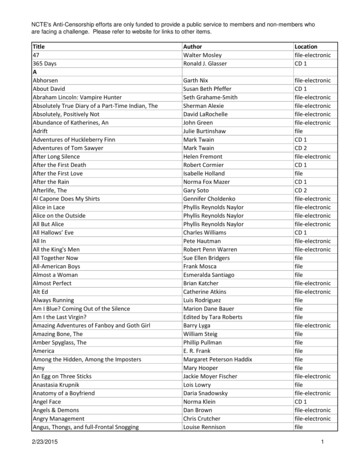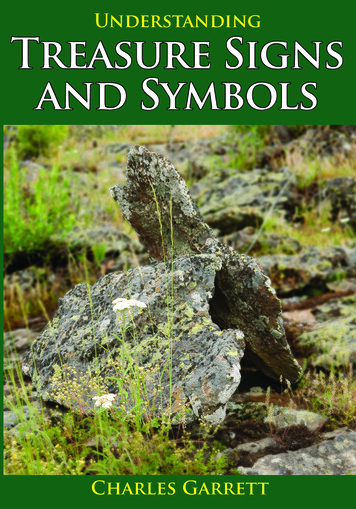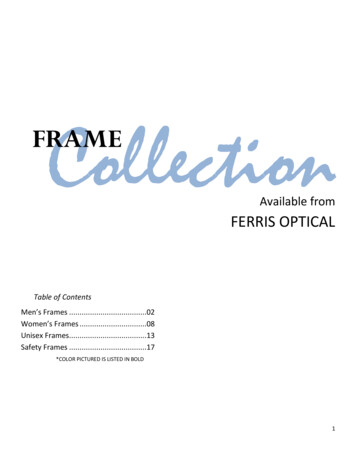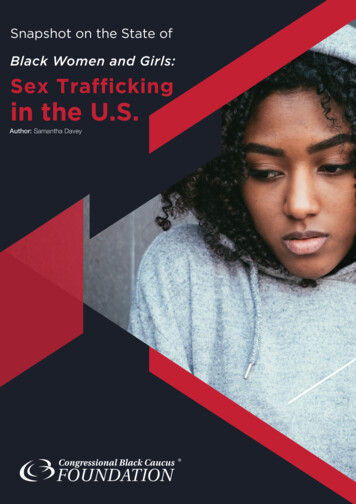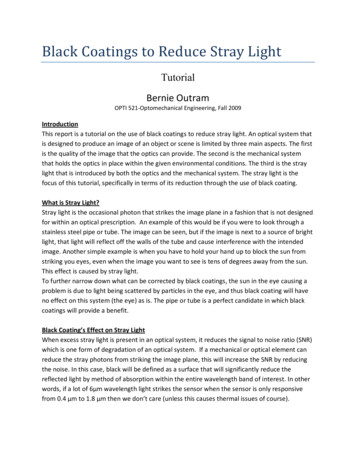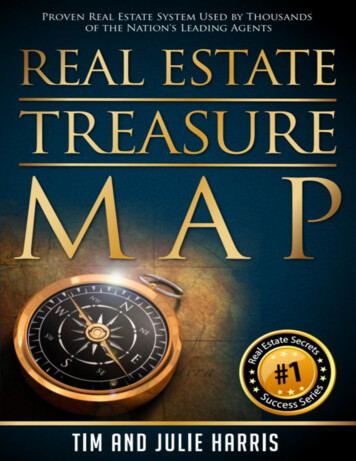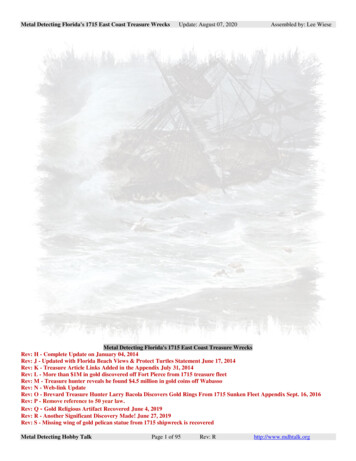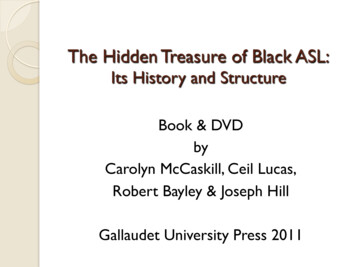
Transcription
The Hidden Treasure of Black ASL:Its History and StructureBook & DVDbyCarolyn McCaskill, Ceil Lucas,Robert Bayley & Joseph HillGallaudet University Press 2011
Table of ContentsChapter 1: IntroductionChapter 2: The Socio-historical FoundationChapter 3: How We Did the StudyChapter 4: PerceptionsChapter 5: Phonological VariationChapter 6: Variation in Syntax and DiscourseChapter 7: The Effects of Language ContactChapter 8: Lexical VariationChapter 9: Conclusions
The Basic Question for Our Project:What are the features of the variety ofAmerican Sign Language (ASL) that people call“Black ASL”? Thereare many anecdotal reports about itsexistence: “Yeah, I see something different ” Wehave considerable evidence of differences inindividual signs (lexical variation).
Project Questions and Goals 2 Hairston & Smith (1983): there is a “Black way ofsigning used by Black deaf people in their owncultural milieu – among families and friends, in socialgatherings, and in deaf clubs” (55). There also exists a 50-year tradition of research onAfrican American Vernacular English (AAVE) showingthat AAVE is a distinct variety of English (seeMufwene et al. 1998 and Green 2004 for reviews). Unique features have been identified at all levels of thelanguage: phonologymorphologysyntaxlexicon
Project Questions and Goals 3Can the same kind of unique features that have beenidentified for AAVE be identified for Black ASL, toshow that it is a distinct variety of ASL?That is the focus of our project.BUT, there is a question that needs to asked BEFOREwe try to answer the basic research question
Project Questions and Goals 4What was the socio-historical realitythat would make Black ASL possible?That is, what conditions might havelead to the creation of a distinctAfrican American variety?
How do language varietiescome about?“All languages, if they have enoughspeakers, have dialects – regional orsocial varieties that develop whenpeople are separated by geographicor social barriers.”(Rickford 1999, African American Vernacular English)
Factors in the development of language varieties 2Both geographic and social factors are involved: Geographic factors: isolation of one community from another boundaries – either geographic and political in nature,e.g., rivers, mountains, swamps, borders patterns of settlement – where people live (or areallowed to live) “ being isolated from other speakers tends to allow a dialect todevelop in its own way, through its own innovations that aredifferent from those of other dialects” (Language Files, 10th ed., p.419).
Factors in the development of language varieties 3 Social factors: socioeconomic statusagegenderethnicityidentityHence, we see differences in working-class andmiddle-class language, caste-defined differences inIndia, varieties shaped by age and gender, andvarieties shaped by ethnicity, e.g., AAVE andSouthwest Spanish.
Geographic Factors in the Formation of BlackASL Schools for Black deaf children were physically isolated. Both separate schools and departments were established insouthern and border states. In some cases, the “Colored Department” was on the samecampus as the white school (e.g. Kansas, Missouri). In other cases, this department was physically separated (e.g.,Georgia, Mississippi). With respect to physical isolation, consider the chartson the next two slides:
Black & White Deaf Schools:Founding and Desegregation1State1.Whiteschool2. Blacksch./ dept.3. DesegregationYears bet.1&2Years bet.2&3DC, KDES18571857, dept.19580101N. nessee18451881, 41882, dept.19652883S. Carolina18491883, dept.19663483Kentucky18231884, dept.1954-606170Florida188518851965080
Black & White Deaf Schools:Founding and Desegregation 2State1.Whiteschool2. Blacksch./ dept3. DesegregationYears bet.1&2Years 80Alabama1858189219683476Missouri18611888, dept19543766Kansas18611888, dept19542766Virginia183919091965 (2 schs)7056Oklahoma18981909, 0192619565630
From the DVD:Chapter 2: The Socio-historical FoundationTEXAS
Conditions favoring the formation of avariety of ASL known as Black ASL? The factors that have played a role in the formation ofspoken language varieties have certainly been present:geographic and social separation and isolation. However, there are complicating issues, including: who were the school teachers (hearing or deaf, Black or White); general pressure to switch to oral instruction (and to suppress signingin the classroom); the nature of the language(s) the children brought to school (ASL?home sign systems? a different variety of ASL?). These factors point to a complex picture that we arebeginning to see reflected in our results.
The History and Structure of Black ASL:The Project at a GlanceObjectives of this four year project: Create a filmed corpus of conversational (vernacular) Black ASLas it is used in the South. We focus on the South because that is where the most radicalsegregation occurred in the education of Black and White Deaf children. Provide a description of the linguistic features that make BlackASL recognizable as a distinct variety of ASL (e.g. greater use of2-handed signs, larger signing space. Chronicle the history of the education of Black Deaf children. Disseminate the findings in the form of teaching materials andinstruction resources.
The History and Structure of Black ASL:The Project at a Glance 2Sites visited in order of the year in which theschools for Black Deaf children were founded: North Carolina (1869)Texas (1887)Arkansas (1887)Alabama (1892)Virginia (1909)Louisiana (1938)
The History and Structure of Black ASL:The Project at a Glance 3 Signers at each site were grouped according to age:oo “Over 55” – attended school during segregation N 58“Under 35” – attended integrated schools N 32Filming occurred during the following:oofree conversationstructured interviews focusing on language use and school history.
From the DVD:Chapter 3: How We Did the Study
From the DVD:Chapter 4: PerceptionsWe looked at participants’ perceptions of languageuse.One theme that emerged:“White Deaf education is better thanBlack Deaf education.”
Linguistic FeaturesWe analyzed 8 different linguisticfeatures that might define Black ASLas a distinct variety.
Black ASL Mosaic2-handed vs. Forehead1-handed signs location vs.loweredUse ofrepetitionSize of signingspaceUse of roleshiftingAmount ofmouthingIncorporation ofAAE into signingVocabularydifferences
From the DVD:Chapter 5: PhonologicalVariationBlack ASLMosaic2-handed signs can become 1-handed.2-handed vs. ForeheadSize of signingHeresome examplesfromIncorporationofvs. are space1-handed signs locationAAE into signingloweredour data:Use ofrepetitionUse of roleshiftingAmount ofmouthingVocabularydifferences
From the DVD:Chapter 5: Phonological VariationSigns produced at the forehead canbe lowered.2-handed vs. ForeheadSize of signingIncorporation of1-handed signs locationspace examplesHerevs.are somefromAAEintosigningloweredour data:Use ofrepetitionUse of roleshiftingAmount ofmouthingVocabularydifferences
From the DVD:Chapter 5: Phonological Variation The “usual” signing space isbetween the shoulders and from thetop of the Sizeheadto the waist.ofForehead2-handed vs.signing spacevs. have1-handed signs locationIncorporationof Claimsbeen madethat BlackloweredAAE into spacesigningsigners use a larger signingthan do White signers.Use ofrepetitionUse of roleshiftingHere are some examplesfrom our data:Amount ofmouthingVocabularydifferences
Variation in Syntax and Discourse How can syntax and discourse vary?: repetition of lexical items, phrases, or sentences use of constructed dialogue (CD) and constructedaction (CA) We tested: the hypothesis that Black signers make more use ofrepetition than do White signers, and the claim that Black signers use more constructed actionand constructed dialogue than White signers.
From the DVD:Chapter 6: Variation in Syntax and DiscourseRepetition2-handed vs. Forehead1-handed signs location vs.loweredUse ofrepetitionCA and CDSize of signingspaceUse of roleshiftingAmount ofmouthingIncorporation ofAAE into signingVocabularydifferences
From the DVD:ChapterThe EffectsLanguage ContactThe7:Effectsof ofLanguageContact Mouthing:2-handed vs.ForeheadSize of signing anecdotaland informalthat BlackIncorporationlocation vs.1-handedsignsaccountsspaceobservationof AAE intoloweredsigners mouthless than White signerssigning African American English (AAE):Amount of AAE:VocabularyUseof rolemouthingdifferencesUse of incorporationofAAElexical itemsand phraseologyintoshiftingrepetitionBlackASL
Lexical Variation We looked at:2-handed vs. ForeheadSize of signingIncorporation of lexicalvariationproducedlocation spontaneouslyvs.1-handedsignsspaceAAE into signinglowered lexical variation discussed by the participants andtheir responses to interviewquestionsAmountofVocabularyUse ofrepetitionUse of roleshiftingmouthing the results of lexical elicitationdifferences
From the DVD:Chapter 8: Lexical VariationNatural Discussion
From the DVD:Chapter 8: Lexical VariationLexical Elicitation
What We Found Black ASL is a distinct variety of American SignLanguage. Black ASL is defined by specific linguistic featuresand shaped by social and geographic factors. Also, not surprisingly, Black ASL is changing as aresult of desegregation and mainstreaming.
Black ASL Mosaic2-handed vs. Forehead1-handed signs location vs.loweredþ Use ofrepetitionþ Size of signingspaceþ Use of roleshiftingMixed Resultsþ Amount ofmouthingMixed ResultsIncorporation ofAAE into signingþ Vocabularydifferencesþ
The History and Structure of Black ASL:Research Team Project Co-Directors Graduate Research Assistants Ceil Lucas, Linguistics, Gallaudet University Carolyn McCaskill, ASL & Deaf Studies, Gallaudet University Robert Bayley, Linguistics, University of California, Davis Joseph Hill, University of North Carolina, Greensboro Roxanne King, Gallaudet University Anika Stephen, Gallaudet University Technical Consultant and Web Master Randall Hogue, Gallaudet University Community Representative Pam Baldwin, Washington, D. C.
AcknowledgmentsThe research reported here was funded by theSpencer Foundation and the National ScienceFoundation, whose support is gratefullyacknowledged.Special thanks to the members of the AfricanAmerican Deaf community who generouslyshared with us the richness of their experienceand language.
Visit our website:blackaslproject.gallaudet.edu
Factors in the development of language varieties 2 Both geographic and social factors are involved: Geographic factors: isolation of one community from another boundaries – either geographic and political in nature, e.g., rivers, mountains, swamps, borders patterns o
